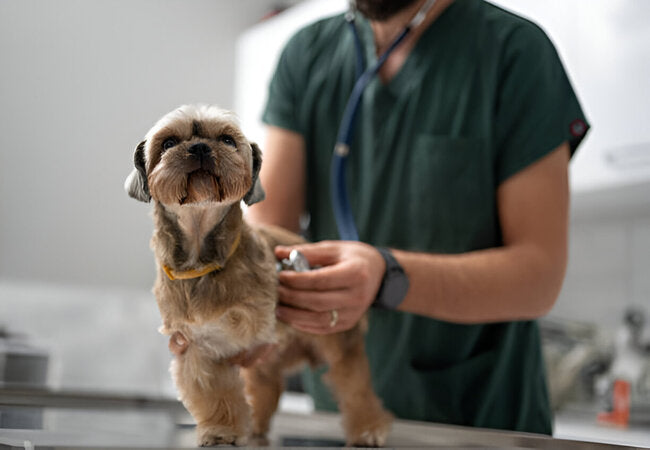Vet‑Approved 2025 Guide: Leg Amputation in Dogs – What to Expect & Thrive After Surgery 🐶

In this article
Vet‑Approved 2025 Guide: Leg Amputation in Dogs – What to Expect & Thrive After Surgery 🐶
Sometimes, due to severe trauma, bone cancer, non-healing fractures, or painful infections, the best way to preserve your dog’s quality of life is by removing an affected limb. Thanks to adaptive ability and modern care, many dogs go on to live active, joyful lives after amputation. In this compassionate 2025 guide by Dr. Duncan Houston BVSc, we cover reasons for leg amputation, surgical techniques, recovery stages, prosthetic options, rehabilitation strategies, and enrichment support tools like Ask A Vet, to help your pup thrive on three legs. 🐾✨
🔍 Why Dogs Need an Amputation
Veterinarians may recommend a leg amputation due to:
- Bone tumors like osteosarcoma or soft-tissue sarcoma
- Severe limb trauma or fractures that can’t be repaired
- Chronic infections, non-healing wounds, or neuropathic pain
- Financial or medical limitations making limb-sparing unviable
Amputation eliminates pain at the source and can improve comfort and mobility:contentReference[oaicite:3]{index=3}.
📋 Pre-Surgical Assessment
- Bloodwork, urinalysis, and chest X-rays to assess overall health and check for metastasis :contentReference[oaicite:4]{index=4}.
- Imaging of the opposite limb and spine to plan post-amputation mobility:contentReference[oaicite:5]{index=5}.
- Discussions about prosthetic versus three-legged life—prosthetics suitable in select cases with commitment:contentReference[oaicite:6]{index=6}.
🛠️ Surgical Techniques
Amputation method varies by limb:
- Front leg: Scapulothoracic disarticulation—removes entire limb, including shoulder blade :contentReference[oaicite:7]{index=7}.
- Hind leg: Can be hip disarticulation (removing at hip joint) or partial femoral amputation:contentReference[oaicite:8]{index=8}.
- Less common: Hemipelvectomy—includes part of the pelvis when tumors are pelvic :contentReference[oaicite:9]{index=9}.
A sterile, meticulous surgical technique ensures proper muscle and skin closure, with ligation of vessels to prevent bleeding:contentReference[oaicite:10]{index=10}.
💉 Anesthesia & Pain Management
Amputations require general anesthesia with pre- and post-operative multimodal pain control—including opioids, NSAIDs, nerve blocks, or pain-soaker catheters for 10–14 days:contentReference[oaicite:11]{index=11}.
🏥 Hospital Stay & Early Recovery
Dogs typically spend 1–3 days hospitalized for monitoring, IV fluids, and pain management. Most begin walking on three legs within 24 hours :contentReference[oaicite:12]{index=12}.
⌛ Home Recovery Timeline
- Days 1–3: Monitor incision, manage pain, prevent licking with cone or recovery suit.
- Weeks 1–2: Restrict activity, use a sling for walks, provide non-slip mats to prevent falls :contentReference[oaicite:13]{index=13}.
- Weeks 3–6: Gradual increase in low-impact exercise; focus on muscle rebuilding.
- Beyond 6 weeks: Most dogs resume active lifestyles; prosthetic fitting is considered if needed.
🔥 Common Complications & Monitoring
- Seromas or fluid pockets at the stump—usually mild; vet should evaluate persistent swelling :contentReference[oaicite:14]{index=14}.
- Incisional infection—watch for redness, discharge; cone use is essential:contentReference[oaicite:15]{index=15}.
- Neuroma—nerve regrowth leading to pain; rare but treatable.
- Phantom pain—extremely rare in dogs:contentReference[oaicite:16]{index=16}.
📈 Long-Term Quality of Life & Mobility
Research shows most amputee dogs adapt well—running, jumping, playing, and even swimming—often without need for prosthesis :contentReference[oaicite:17]{index=17}.
🦴 Prosthetics & Orthotics
Prosthesis may help rebuild symmetry and reduce stress on remaining limbs, though they come with added complexity, cost, and adjustment:contentReference[oaicite:18]{index=18}.
💪 Rehabilitation Strategies
- Physical therapy—muscle strengthening, balance training, underwater treadmill :contentReference[oaicite:19]{index=19}.
- Focus on keeping your dog at a healthy weight to protect joints.
- Ensure home environment is safe—avoid slippery floors and stairs during early recovery:contentReference[oaicite:20]{index=20}.
🐶 Enrichment & Comfort Tools
- Ask A Vet: Use remote consults during recovery to assess mobility, wound healing, and pain management.
📞 When to Contact Your Vet
- Inability to walk using remaining limbs after several days.
- Persistent swelling, bleeding, or foul-smelling discharge.
- Signs of severe pain, fever, vomiting, or lethargy.
- Compensatory lameness or pain in other limbs—may need assessment.
🏁 Final Thoughts
Amputation may feel overwhelming, but it often provides the best path to pain relief and quality of life. With skilled surgery, thoughtful rehabilitation, and ongoing support—from home adaptations to tools like Ask A Vet,many dogs thrive as three-legged family members. Their resilience is inspiring—they quickly learn, adapt, and redefine what a "full" life looks like. 🐾❤️
Considering amputation or evaluating your dog’s recovery? Visit Ask A Vet anytime for personalized guidance from professionals who understand your journey. 🩺✨






